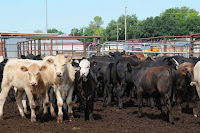Environmental groups place a lot of attention on trying to stop new oil, gas, and coal development since current fossil fuel projects would likely already blow us past the less-than 2°C upper limit for warming laid out in the 2015 Paris Climate Agreement. In fact, there’s a whole movement, known as “Keep It in the Ground,” predicated on this idea.
But when faced with a resurgence of support for fossil fuels from the White House, perhaps just as important is talking about how to “Keep It in the Cow,” according to some reports. Right now, experts predict agriculture is set to eat up half the greenhouse gas emissions the world can release by 2050 and still stay below 2°C (3.6°F) of warming.
That is, unless the world takes a big bite out of its meat consumption, especially from cattle and other livestock that chew their cud, say researchers at Chalmers University of Technology in Sweden. Raising these ruminants produces a lot of methane, a much more potent but shorter-lived greenhouse gas than carbon dioxide.
While “Meatless Mondays” is one approach to this problem, their studies show that it’s not necessarily how much meat people eat that’s linked to the climate impacts of their diet. Instead, it’s the amount of beef, lamb, and dairy.
A 2017 Chalmers study concluded that: “A switch from diets rich in ruminant meat to diets with meat from monogastric animals (pork, chicken) reduces [methane] emissions by almost the same amount as a switch to an entirely vegan diet.” Researchers at the University of Oxford in 2016 found similar benefits, concluding that shifting to a vegetarian diet could lessen greenhouse gas emissions by two-thirds.
(If you want to eat vegan, of course, that’s also an option. In addition, eggs and dairy each have about half the climate impact of eating chicken and beef.)
It’s worth noting that many of these studies don’t take into account the land-use changes that come with supporting different diets. However, the United Nations (UN) Food and Agriculture Organization estimates that about 70 percent of Amazon forest has been converted to pasture for livestock, and the Chalmers researchers note swapping in beans for bovine burgers likely wouldn’t drive an increase in cropland.
Read more at Meeting Paris Goals Means Dealing with Climate Impacts of Eating Meat

No comments:
Post a Comment